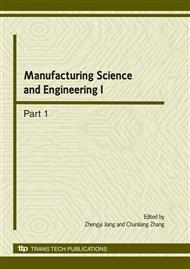p.4251
p.4257
p.4261
p.4265
p.4271
p.4277
p.4282
p.4287
p.4293
Influence of Specimen Sampling on Internal Residual Stress Test
Abstract:
Using Finite Element Method, the changing rules of residual stresses in the test specimen cut out from a quenched plate were analyzed, and suitable dimensions of the specimen for crack compliance method test was recommended. The results show that cutting has great influences on residual stresses in the specimen edge areas to a range of about one thickness, while it has little influences on stresses at the center part of the specimen; cutting mainly influences stresses normal to the cutting plane, while it has little effect on stresses parallel to the cutting plane; specimen with length bigger than 2.67 times the thickness and width bigger than 2 times the thickness is suitable for crack compliance method test, under these conditions peak stresses losing in crack compliance method results is less than 5% compared with surface stress X-ray diffraction results.
Info:
Periodical:
Pages:
4271-4276
Citation:
Online since:
March 2010
Authors:
Keywords:
Price:
Сopyright:
© 2010 Trans Tech Publications Ltd. All Rights Reserved
Share:
Citation:


